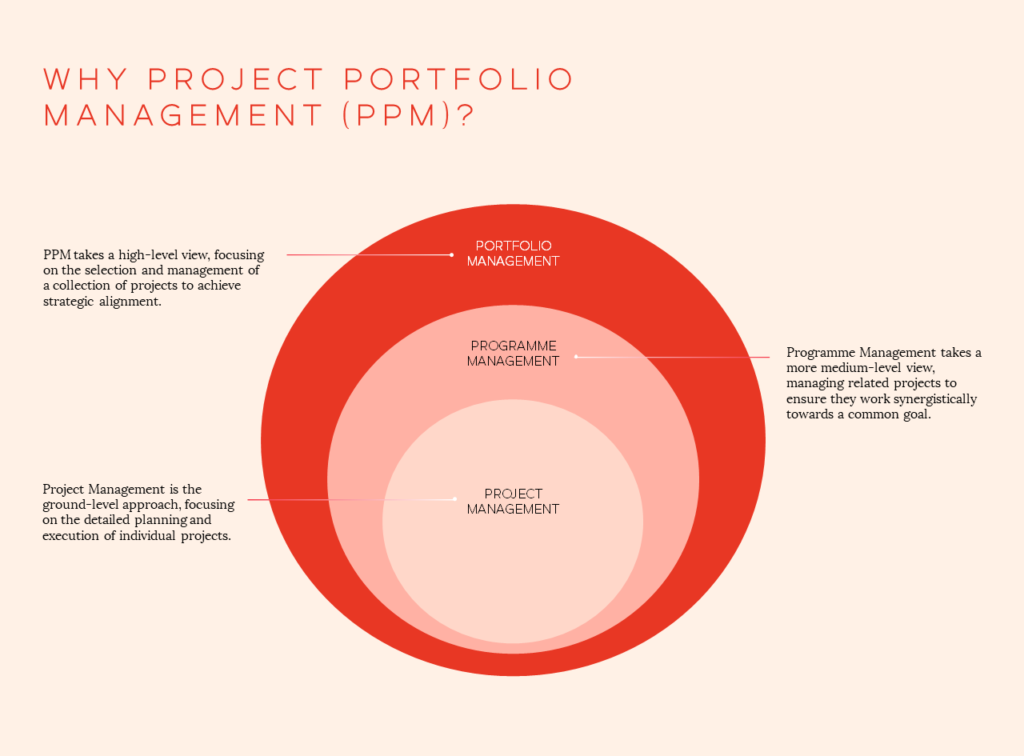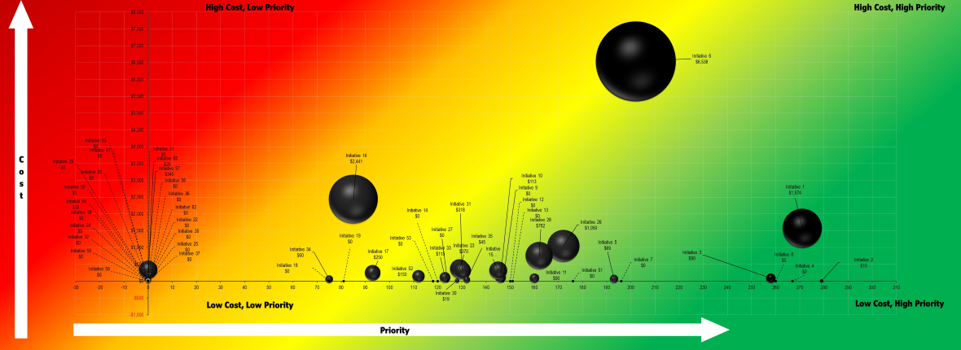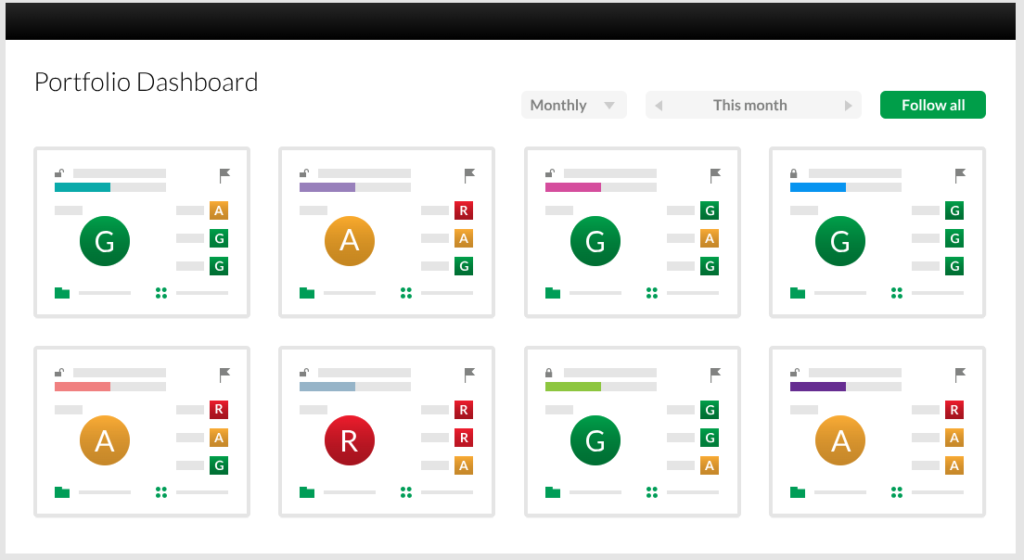
Project Portfolio Management
Project Portfolio Management (PPM) is a critical aspect of strategic planning and execution within an organisation.
Jon Webster
Project Portfolio Management, or PPM, isn’t just about overseeing individual projects. It’s about weaving together an array of projects into a cohesive portfolio, carefully balancing risk and reward, to drive organisational success. In today’s fast-paced and competitive business environment, the ability to align projects with strategic goals, optimise resources, and adapt to change is more vital than ever. Whether you’re a seasoned project manager or new to the field, understanding PPM can unlock new efficiencies and lead to better decision-making across your organisation.
This guide serves as a comprehensive roadmap to the intricate world of PPM. Through a step-by-step exploration, it will demystify the core concepts, methodologies, and tools that are pivotal to effective portfolio management. It will guide you in selecting the right projects, balancing your portfolio, managing resources adeptly, and measuring performance with precision. Each section is designed to provide actionable insights and practical knowledge, enabling you to apply PPM principles in real-world scenarios.
But how does this all translate to tangible benefits for you and your organisation? Implementing PPM is more than a theoretical exercise; it’s a strategic imperative that can lead to a higher return on investment, enhanced alignment with business objectives, and a more agile response to market changes. By delving into this guide, you’re not merely learning about a management concept; you’re embarking on a journey that can transform how your organisation plans, executes, and thrives in an ever-evolving business landscape.
Along the way, you’ll discover how to pick the right projects, how to balance your portfolio like a skilled acrobat, and how to keep track of everything without getting lost in the maze.

What is project portfolio management?
Project Portfolio Management (PPM) is the coordinated management of interconnected projects to align with organisational objectives, maximise benefits and optimise resource usage.
A well-managed portfolio maintains a balanced mix of projects in terms of risk, reward, strategic alignment and other factors. This balance ensures a resilient and diversified approach to achieving business goals.
Project portfolio management provides defined governance and process to guide decision-making, prioritisation and execution. This governance ensures consistency, quality and alignment with the business strategy as well as the time, resources and budget available. (See Better business strategy plans with Project Portfolio Management)
What is a project portfolio?
A project portfolio is a collection of projects and/or programmes that are managed and coordinated as a single entity to achieve strategic objectives. Unlike individual projects that may operate independently, the projects within a portfolio are interconnected in terms of overarching business goals, resources or dependencies.
A portfolio can include various types of projects, ranging from short-term tactical projects to long-term strategic initiatives. These projects may differ in size, scope, complexity and risk but are brought together under the umbrella of the portfolio.
What is project portfolio management in simple terms?
Imagine your organisation is a grand orchestra, filled with various musical instruments, all playing their unique part. Some instruments are loud and powerful, while others are soft and subtle. These instruments are your projects, each with different goals, timelines and resources.
Now, you’re spending a lot of money on this orchestra so conducting it to create harmonious music rather than a cacophony is important. That’s where Project Portfolio Management, or PPM, comes in. It’s the conductor’s baton that aligns, balances and guides these various projects to create a symphony that resonates with your organisation’s big picture.
In short, Project Portfolio Management ensures that you gain the benefit of your investment in projects rather than a lot of expensive chaos and noise.
The magic lies in managing your projects not as isolated entities but as interconnected parts of a grand design. Through this guide’s creative exploration of PPM, you’ll not only learn the theoretical notes but also how to compose your own business symphony, transforming your organisation’s projects into a melody of success, efficiency, and innovation.
What types of industries and companies benefit from project portfolio management?
Project Portfolio Management (PPM) can be valuable across a wide range of industries and company types. Its principles and techniques are applicable to virtually any organisation that manages multiple projects, regardless of size or sector. Here’s a look at some of the industries and companies that can particularly benefit from PPM:
Information Technology (IT)
- Software Development Firms: Managing multiple software projects with different timelines, resources, and goals.
- IT Service Providers: Balancing service improvement projects and client demands.
Healthcare
- Hospitals and Health Systems: Coordinating various projects related to patient care, facility upgrades, regulatory compliance, etc.
- Pharmaceutical Companies: Managing research and development projects, clinical trials, and regulatory submissions.
Finance and Banking
- Banks and Financial Institutions: Implementing new technologies, regulatory compliance projects, or customer service initiatives.
- Investment Firms: Balancing various investment projects and risk management strategies.
Manufacturing
- Manufacturing Companies: Managing production line improvements, new product development, and supply chain initiatives.
- Automotive Manufacturers: Coordinating projects across design, production, distribution, and after-sales service.
Energy and Utilities
- Oil and Gas Companies: Overseeing exploration, production, and environmental compliance projects.
- Utility Providers: Managing infrastructure upgrades, regulatory compliance, and sustainability initiatives.
Government and Public Sector
- Local and National Governments: Planning and overseeing public works projects, policy initiatives, and community programs.
- Defence Contractors: Coordinating multiple projects for government contracts and compliance requirements.
Telecommunications
- Telecom Companies: Managing network expansion, technology upgrades, and customer experience enhancement projects.
Retail and Consumer Goods
- Retail Chains: Coordinating store openings, marketing campaigns, and supply chain projects.
- Consumer Goods Manufacturers: Balancing new product development, production scaling, and market expansion projects.
Construction and Real Estate
- Construction Firms: Overseeing multiple construction projects, from residential buildings to large commercial properties.
- Real Estate Developers: Managing development, sales, and regulatory projects across different properties.
PPM’s universal applicability means that virtually any organisation with a need to manage multiple projects can benefit from its implementation. It aids in strategic alignment, resource optimisation, and risk management, driving efficiency and success across varied sectors and business landscapes. Whether a small start-up juggling a few key projects or a multinational corporation managing a complex portfolio, PPM provides the tools and frameworks to navigate the challenges and achieve objectives.

Why project portfolio management?
Project Portfolio Management (PPM) is important because it drives the overall efficiency and success of the projects you are investing in. It ensures that an organisation’s projects are aligned with its strategic goals, facilitates the optimal use of resources, enables prioritisation of projects based on their value and potential return on investment, and provides a structured framework for monitoring and managing risks.
The advantages of portfolio management
Choosing Project Portfolio Management (PPM) over other methods offers distinct advantages, as it focuses on managing a portfolio of projects as an integrated whole rather than handling them individually. Here’s why PPM is often preferred:
- Strategic Alignment: PPM ensures that all projects align with the overall business strategy, thus guaranteeing that resources are directed towards achieving the most important organisational goals.
- Resource Optimisation: It helps in allocating resources (such as time, money, and staff) more efficiently across various projects, reducing waste and improving utilisation.
- Risk Management: By viewing the portfolio as a whole, PPM allows for better assessment and mitigation of risks that might be missed when managing projects separately.
- Balanced Portfolio: PPM enables the creation of a balanced mix of projects, considering factors like risk, reward, and alignment, ensuring a diversified and resilient portfolio.
- Improved Decision-making: With a holistic view, PPM provides better insights and analytics, supporting more informed decisions on project selection, prioritisation, and execution.
- Enhanced Agility: PPM fosters a more flexible and responsive approach to changes in market conditions or organisational priorities, allowing for timely adjustments to the portfolio as needed.
In contrast to isolated project management, PPM offers a more comprehensive and aligned approach, making it a valuable method for organisations seeking to maximise their success in executing multiple, interrelated projects.
Benefits of project portfolio management in detail
The benefit of project portfolio management is that your organisation will gain more of what it wants from its investment of money, time and resources in projects – and less will be wasted on duplication of effort or things that are not important in the grander scheme of things.
There specific advantages and improvements too that organisations can achieve through project portfolio management. These benefits contribute to overall business success and competitiveness.
Here’s a breakdown:
Alignment with Business Strategy
- Strategic Focus: Ensures that projects are chosen and managed according to the organisation’s overall strategic objectives, ensuring a coherent direction.
- Higher Success Rate: By aligning projects with business goals, the likelihood of success is increased, as resources are directed towards initiatives that matter most.
Efficient Use of Resources
- Cost Savings: PPM allows for the efficient allocation of resources such as budget, personnel, and time, reducing unnecessary expenditures.
- Maximised Utilisation: Ensures that resources are deployed where they can provide the greatest value, thereby improving overall productivity and efficiency.
Improved Decision-making
- Informed Choices: Provides data-driven insights that enable management to make more informed, strategic decisions about project selection, prioritisation, and execution.
- Agility: Enhances the ability to respond to market changes, emerging opportunities, or challenges by enabling quick adjustments to the project portfolio.
Enhanced Risk Management
- Risk Mitigation: Facilitates the identification and management of potential risks across the portfolio, allowing for proactive measures to mitigate potential negative impacts.
- Resilience: Helps in building a more resilient portfolio that can withstand various uncertainties and market fluctuations.
Better Financial Management
- Budget Control: Supports effective budget management and control across various projects, avoiding overspending and contributing to the bottom line.
- Increased ROI: By focusing on high-value projects and managing them effectively, PPM can lead to an increased return on investment.
Greater Transparency and Collaboration
- Clear Communication: Enhances communication and collaboration among stakeholders, ensuring that everyone has a clear understanding of project statuses and objectives.
- Stakeholder Engagement: Engages various stakeholders in the decision-making process, leading to increased buy-in and support.
Quality and Compliance Assurance
- Standardisation: Helps in implementing consistent processes and standards across projects, ensuring quality control.
- Regulatory Compliance: Assists in managing projects in line with regulatory and compliance requirements, reducing legal risks.
Improved Customer Satisfaction
- Customer Focus: By aligning projects with customer needs and market demands, PPM helps in enhancing customer satisfaction and loyalty.
- Competitive Edge: Offers a systematic approach to project management that can create a competitive advantage through efficiency, agility, and innovation.
The business benefits of Project Portfolio Management extend beyond mere project oversight. They reach into the core of organisational effectiveness and strategic alignment, contributing to financial success, risk management, customer satisfaction, and overall business growth. By integrating PPM into their operations, organisations can gain a robust toolset for navigating the complex and competitive landscape of modern business.
Project portfolio management vs. program management vs. project management
The concepts of Project Portfolio Management (PPM), Program Management, and Project Management are often used interchangeably but have distinct differences and applications.
- PPM takes a high-level view, focusing on the selection and management of a collection of projects to achieve strategic alignment.
- Program Management takes a more medium-level view, managing related projects to ensure they work synergistically towards a common goal.
- Project Management is the ground-level approach, focusing on the detailed planning and execution of individual projects.
Understanding the differences and interconnections between these three levels of management enables organisations to apply the right approach in the right context, leading to more efficient and effective achievement of their goals.
Here’s a detailed comparison:
Project Portfolio Management (PPM)
Definition: PPM is the process of strategically managing a collection of projects as a whole to achieve organisational objectives.
Focus: The primary goal is alignment with business strategies, resource optimisation, risk management, and ensuring a balanced mix of projects that provide value.
Scope: Covers the entire set of projects within an organisation or a specific business unit.
Responsibility: Usually handled by senior management or dedicated portfolio managers.
Key Benefit: Enables an overarching view of all projects and their combined impact on business success.
Program Management
Definition: Program Management involves managing related projects in a coordinated way to obtain benefits that wouldn’t be possible if managed separately.
Focus: Emphasises the optimisation of resources across projects, alignment with strategic objectives, and interdependency management within the program.
Scope: Encompasses multiple related projects working towards a common goal or benefit.
Responsibility: Usually managed by a program manager who oversees the interconnected projects.
Key Benefit: Enhances efficiency, collaboration, and synergy between related projects, ensuring that they work together towards a common aim.
Project Management
Definition: Project Management is the application of knowledge, skills, tools, and techniques to project activities to meet specific project objectives.
Focus: Centred on planning, executing, controlling, and closing an individual project.
Scope: Limited to a single project with defined goals, timelines, budgets, and deliverables.
Responsibility: Handled by a project manager, responsible for the day-to-day management of the project.
Key Benefit: Ensures the successful completion of a project within its defined constraints, such as scope, time, and cost.

How to manage project portfolios
Managing a project portfolio is more than overseeing a collection of projects; it’s about orchestrating various initiatives to work synergistically towards the organisation’s strategic goals.
Managing project portfolios in practice requires a nuanced and systematic approach that spans the entire lifecycle of the portfolio. It involves a delicate balance of strategic alignment, prioritisation, resource allocation, risk management, performance monitoring, and continuous improvement. By applying these practical steps and leveraging the right tools, organisations can effectively navigate the complexities of portfolio management, driving success in a way that aligns with the broader business goals. It’s a dynamic and evolving practice that fosters agility, efficiency, and focused direction in the ever-changing world of business.
Here are some of the key elements for how it is done in practice:
1. Identify goals
Start by understanding the organisation’s strategic objectives and how the portfolio should support them. This will need wide agreement across senior stakeholders or risk the management of the portfolio being undermined.
2. Select Projects
Choose only projects that align with these goals, ensuring that they contribute to the desired outcomes.
3. Portfolio prioritisation
Portfolio prioritisation is the process of ranking projects and programmes within a portfolio according to their alignment with strategic objectives, potential value, risk, and other relevant factors. It serves as a guide for decision-making, resource allocation, and focus.
Importantly, portfolio prioritisation is not a one-off exercise. You must regularly review and adjust priorities to ensure ongoing alignment with changing business needs.
We provide a framework for optimising and prioritising your project portfolio tailored to your strategy that places managing for value at its core.
Read more about our framework for portfolio prioritisation.
4. Allocate resources
Assign resources like budget, time, and personnel to projects based on their priority and requirements
5. Monitor utilisation
Continuously track resource use to prevent over or underutilisation and to ensure efficiency.
6. Identify and mitigate risks
Understand the potential risks across the portfolio and how they may impact individual projects or the portfolio as a whole. Implement proactive measures to reduce or eliminate risks, ensuring the resilience of the portfolio.
7. Performance monitoring
Define key performance indicators (KPIs) to gauge progress and success. Regularly assess performance, generating reports for stakeholders to provide insights and drive decision-making.
8. Stakeholder communication and engagement
Maintain open communication, keeping stakeholders informed and engaged throughout the portfolio lifecycle.
9. Governance and compliance
Establish clear governance processes and standards for managing the portfolio. Adhere to relevant regulations and internal policies, reducing legal and reputational risks.
10. Continuous Improvement
Assess the success of the portfolio in achieving its objectives, identifying lessons learned. Continuously refine and enhance practices, incorporating feedback and evolving with industry best practices
11. Utilise Technology
Leverage PPM Tools: Utilise Project Portfolio Management software to facilitate planning, tracking, collaboration, and reporting.

Project portfolio management software
Selecting the right project portfolio software is a critical decision that can greatly influence the success of your project portfolio management (PPM). This tool should align with your organisation’s unique needs and objectives.
From decades of experience, we firmly believe that key to those requirements is straightforwardness. Not simplicity exactly, as inevitably project portfolios are complex, but straightforwardness for those interacting with the software. This is particularly important of the reporting functionality where reports need to tell senior stakeholders what they need to know quickly and directly. This is key to the ongoing success of project portfolio management.
If you would like support with selecting the best tool for you, we’d be happy to help and have supported a number of such exercises. You can get in contact with the form below. One tool we recommend you taking a look at is Kivue Perform, which is particularly good at increasing clarity up to executive level.

Project portfolio management solution
A complete project portfolio management solution combines the right approach for your organisation with all the needed expertise and stakeholder management skills, processes, software and resources.
If you are looking for a complete solution, Practicus can provide it for you through its PMO as a Service solution.
Project portfolio manager
The role of a Project Portfolio Manager (PPM) is a senior and strategic one within an organisation, it is vitally important to have someone who has not only the technical skills but also the soft skills for engaging the executive board and senior management team effectively.
What is a project portfolio manager?
A Project Portfolio Manager is a professional role that involves overseeing and managing a collection of projects and programmes within an organisation’s project portfolio. This role is distinct from that of a project or programme manager and involves a more strategic level of responsibility.
Hiring a project portfolio manager
Hiring a Project Portfolio Manager is a significant step for an organisation, as this role plays a crucial part in aligning multiple projects with the company’s strategic objectives.
If you would like support with a project portfolio manager position, please get in contact through our interim management or permanent hires services.
FAQ
Answers to popular organisational design questions.
What is the PPM strategy?
Project portfolio management (PPM) is a strategy that analyses potential projects based on their anticipated successes and associated risks, subsequently allocating staff, resources and timelines to optimise organisational performance.
What is portfolio management in project management?
Portfolio management involves the choosing, prioritising and overseeing of an organisation’s projects and programmes in accordance with its strategic aims and ability to execute. The objective is to strike a balance between the initiation of change efforts and the continuation of everyday operations, all the while maximising return on investment.
What are the 4 types of portfolio management?
- Active Portfolio Management
- Passive Portfolio Management
- Discretionary Portfolio Management
- Non-discretionary Portfolio Management
- Active Management emphasizes ongoing oversight and adaptability.
- Passive Management emphasizes initial alignment with less ongoing intervention.
- Discretionary Management emphasizes flexibility and individual judgment within broad guidelines.
- Non-Discretionary Management emphasizes rule-based decision-making with limited flexibility.
Active Project Portfolio Management
- Approach: Involves hands-on, continuous monitoring and realignment of the portfolio to ensure it aligns with the organisation’s strategic goals.
- Decision Making: Frequent decisions are made to adjust, prioritize, or terminate projects based on ongoing analysis and assessment.
- Adaptability: Highly responsive to changes in organizational goals, market conditions, or project performance.
- Cost: Potentially higher due to the need for constant oversight and realignment.
Passive Project Portfolio Management
- Approach: Focuses on a set-and-forget strategy where projects are selected and prioritized, but ongoing intervention is minimal.
- Decision Making: Decisions are made initially, but there is less ongoing adjustment or realignment of projects.
- Adaptability: Less responsive to changes or emerging opportunities and challenges.
- Cost: Typically lower due to reduced need for continuous monitoring and decision-making.
Discretionary Project Portfolio Management
- Approach: A flexible approach where the portfolio manager has significant latitude to make decisions on project selection, prioritization, and execution.
- Decision Making: The portfolio manager has the discretion to make choices within agreed-upon guidelines and objectives.
- Adaptability: Can be tailored to the unique needs and objectives of the organization.
- Cost: May vary depending on the level of flexibility and individualized decision-making.
Non-Discretionary Project Portfolio Management
- Approach: A more rigid approach where specific rules and criteria guide all project decisions, leaving little room for subjective judgment.
- Decision Making: Decisions are made based on predetermined criteria or policies, with limited flexibility.
- Adaptability: Less adaptive to changing circumstances, relying on established rules and guidelines.
- Cost: May vary but typically involves clear boundaries on decision-making and expenditures.
What is the difference between PMO and PPM?
PMO & PPM represent a relationship between programme management, projects, and portfolios. It is typical to regard the Project Management Office (PMO) as a place and Project Portfolio Management (PPM) as a process. However, in today’s evolving PMO environment, the distinctions can often become blurred.
What is PPM workflow?
PPM utilises workflows and data to prioritise projects according to their strategic value and anticipated impact on the business, aligning your investments with application development strategy. PPM aids in concentrating development resources on the most crucial projects and in allocating investments to high-value projects.
What is PPM in agile?
Project and portfolio management (PPM) simply refers to the centralised management of projects, and Agile PPM takes this a step further by incorporating real-time data to prioritise work. This enables organisations to respond to rapidly changing market conditions and deliver value to customers more swiftly.
Further reading
Books:
- “The Strategic Project Office: A Guide to Improving Organizational Performance“ by J. Kent Crawford
- “Portfolio Management for New Products” by Robert G. Cooper, Scott J. Edgett, and Elko J. Kleinschmidt
- “Project Portfolio Management: A Practical Guide to Selecting Projects, Managing Portfolios, and Maximizing Benefits” by Harvey A. Levine
- “Project Portfolio Management Tools & Techniques” by Rad. Parviz F.
Articles:
- “Project Portfolio Management – A Case Study at Transportation Industry” by Ranti Oktaviani (Procedia – Social and Behavioral Sciences)
- “The Role of Project Portfolio Management in Increasing the Effectiveness of a Project Portfolio” by Petr Fiala (Management and Economics)
Get Support for portfolio management
Make contact today. All discussions in confidence.

BOYD KERSHAW
Co-Founder and Director






